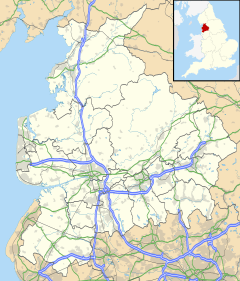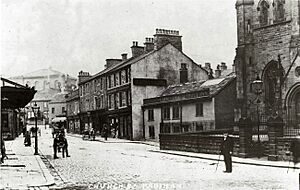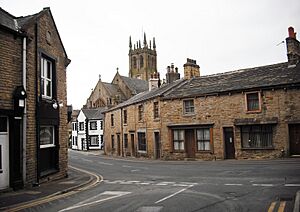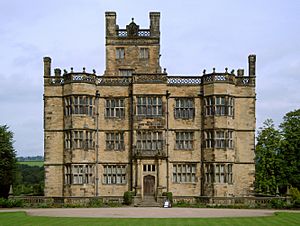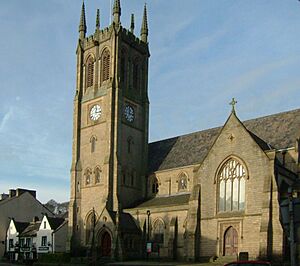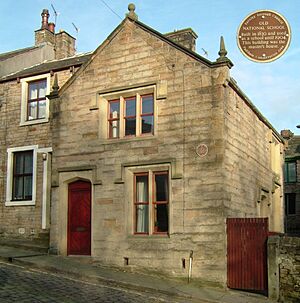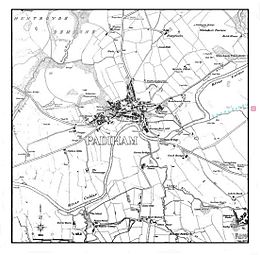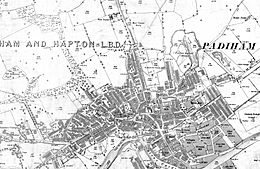Padiham facts for kids
Quick facts for kids Padiham |
|
|---|---|
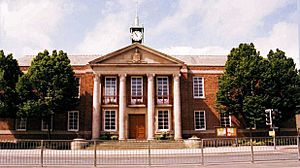 Padiham Town Hall in 1994, designed by Bradshaw Gass & Hope 1938 |
|
| Area | 2.46 sq mi (6.4 km2) |
| Population | 10,098 (2011) |
| • Density | 4,105/sq mi (1,585/km2) |
| OS grid reference | SD7933 |
| Civil parish |
|
| District |
|
| Shire county | |
| Region | |
| Country | England |
| Sovereign state | United Kingdom |
| Post town | BURNLEY |
| Postcode district | BB12 |
| Dialling code | 01282 |
| Police | Lancashire |
| Fire | Lancashire |
| Ambulance | North West |
| EU Parliament | North West England |
| UK Parliament |
|
Padiham is a lively market town and civil parish in Lancashire, England. It's located right by the River Calder. You can find it north-west of Burnley and north-east of Clayton le Moors and Great Harwood. The beautiful foothills of Pendle Hill surround it to the north-west and north-east. In 2011, about 10,098 people lived in Padiham.
Contents
A Look at Padiham's Past
The name "Padiham" likely comes from old English words meaning "Padda's home." Padda might have been a priest from the 600s.
How Padiham Grew Over Time
Even though Padiham's name is very old, it wasn't mentioned in the 1086 Domesday Book. For a long time, Padiham was a market town where people from the Pendleside area bought and sold goods. A water-powered mill was built here by 1311. The town grew a lot during the Industrial Revolution, a time when new machines changed how things were made. Today, the town centre is a special area kept to show its history.
Changes in Population
Padiham's population was highest around 1921, with about 14,000 people. It then dropped to about 10,000 by the early 1960s. This happened because many people moved south to find work. The old industries like cotton, coal, and engineering were not as strong anymore.
Royal Visits
Queen Elizabeth II and Prince Philip visited the area in 1955. This was part of their tour of Lancashire after the Queen's Coronation.
How Padiham is Governed
Padiham used to be a small area within a larger parish. In 1866, it became its own civil parish. From 1894 to 1974, it had its own local government called an urban district.
Padiham Today
Since 1974, Padiham has been part of the Borough of Burnley. In 2001, a new Padiham civil parish was created, and a Town Council started in 2002. This council helps manage local affairs. People living in Padiham vote for councillors to represent them on the Burnley Borough Council and Lancashire County Council. Padiham is also part of the Burnley area, which elects a Member of Parliament to the UK Parliament.
People and Numbers
In 2011, Padiham had a population of 10,098. Most people living in Padiham are White British. The largest religious group is Christian. Many adults in the town are working.
| Year | 1901 | 1911 | 1921 | 1931 | 1939 | 1951 | 1961 | 2001 | 2011 | ||||||||||||
|---|---|---|---|---|---|---|---|---|---|---|---|---|---|---|---|---|---|---|---|---|---|
| Population | 12,205 | 13,635 | 12,471 | 11,633 | 10,011 | 10,041 | 9,899 | 8,998 | 10,098 | ||||||||||||
| UD (pre-1974) CP (2001 onwards) | |||||||||||||||||||||
Padiham's Economy and Jobs
In the 1800s, Padiham was known for coal-mining and weaving. By 1906, there were twenty cotton mills! The oldest preserved mill, Victoria Mill, was built in 1852. Many cotton workers were part of the Padiham Weavers' Association.
How Industry Changed
The Leeds and Liverpool Canal and the railway helped Padiham's industries grow. Coal was easy to find, which was great for the cotton mills. However, after the 1930s, the cotton mills started to close. The last big factory, Baxi, closed in 2007.
Today, Padiham has a modern business park called Shuttleworth Mead. It opened in 2001 where the old Padiham Power Station used to be. Companies like Supanet (an internet provider) and Graham & Brown (a wall coverings company) are located there. Fort Vale Engineering also opened a new factory nearby in 2007, creating jobs for local people.
Cool Places to See in Padiham
Padiham and the surrounding area have some interesting historic buildings and parks.
Historic Houses and Churches
- Huntroyde Hall (from 1576) and Simonstone Hall (from 1660) are still private homes.
- Gawthorpe Hall is a beautiful old house managed by the National Trust and Lancashire County Council. It used to belong to the Shuttleworth family.
- St Leonard's Parish Church was built between 1866 and 1869. It's a Grade II listed building, meaning it's historically important.
- Padiham Town Hall, built in 1938, is also a Grade II listed building.
Parks and Memorials
- Padiham Memorial Park was opened in 1921 to remember those who died in the First World War. It now also honors victims of the Second World War. The park is split into two parts by the River Calder. The upper part has gardens and memorials, while the lower part has sports facilities like bowling greens and tennis courts. It's a "Green Flag award" winner, meaning it's a great park!
- The Air Crash Memorial in the park remembers young people from Padiham who died in a plane crash in Spain in 1970.
Other Interesting Buildings
- The former Padiham Building Society headquarters on Burnley Road is a locally listed building. It was built in the 1950s and now has offices.
- Several old farms and houses like Hargrove and High Whitaker Farm have long histories, some dating back to the 16th or 17th centuries.
Media and Entertainment
You can get local news and TV from BBC North West and ITV Granada. Local radio stations include BBC Radio Lancashire and Heart North West. The town is also served by local newspapers like the Burnley Express.
Filming Location
Between 1994 and 1996, the BBC comedy-drama All Quiet on the Preston Front was filmed in Padiham.
Getting Around Padiham
Trains
Padiham used to have its own railway station, which opened in 1877. However, it closed in 1957. The old railway line has now been turned into a walking, cycling, and horse-riding path called the Padiham Greenway. The closest train station now is at Hapton, about 2 miles away.
Buses
Local bus companies connect Padiham to nearby towns like Accrington, Burnley, Nelson, and Blackburn.
Roads
Padiham is close to the M65 motorway, making it easy to get to other major roads like the A56 and the M66, which leads to the Manchester motorway network.
Air Travel
The nearest airport is Manchester, which is about a 50-minute drive away.
Historic Maps
These maps show how Padiham has changed over time.
-
3: A map showing historical locations around Padiham, like Read Hall and Gawthorpe Hall.
Famous People from Padiham
Padiham has been home to several notable individuals:
- William Blezard (1921–2003): A composer who worked with famous artists.
- Thomas Birtwistle (1833–1912): A trade union leader involved in local weavers' strikes.
- Maurice Green (1906–1987): A well-known editor for major newspapers like The Financial Times.
- Harry Hill (1916–2009): A cyclist who won a bronze medal at the 1936 Olympics in Berlin. He even cycled 200 miles to get to London for the Olympics!
- Sir James Kay-Shuttleworth, 1st Baronet (1804–1877): He helped set up teacher training in England and was connected to Gawthorpe Hall.
- Alfred Tysoe (1874–1901): A Padiham-born athlete who won two gold medals at the 1900 Olympic Games.
- Andy Payton (born 1967): A professional footballer, often called the "Padiham Predator."
Freedom of the Town
The "Freedom of the Town" is a special honor given to people who have done great things for Padiham.
- Robert "Bob" Clark received this honor on June 29, 2021.


